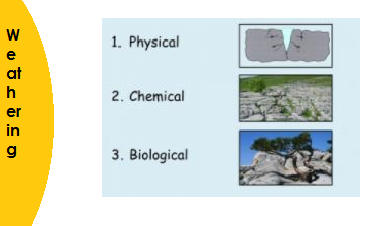
A Weathering causes the disintegration of rock near the surface of the earth. Plant and animal life, atmosphere and water are the major causes of weathering. Weathering breaks down and loosens the surface minerals of rock so they can be transported away by agents of erosion such as water, wind and ice.
Weathering is breaking down rocks, soil, and minerals as well as wood and artificial materials by contacting the atmosphere, water, and biological organisms of the Earth. Weathering takes place in situ, i.e. in the same place, with little or no movement.
There are Three Types of weathering,
Weathering is often divided into mechanical weathering and Chemical weathering processes. Biological weathering may be part of both processes, in which living or once – living organisms contribute to weathering.
Physical or Mechanical Weathering
Physical or Mechanical weathering is the disintegration of rock into smaller and smaller fragments. Frost action is an effective form of mechanical weathering. When water trickles down into fractures and pores of rock, then freezes, its volume increases by almost 10 percent. This causes outward pressure of about 30,000 pounds per square inch at -7.6 Fahrenheit. Frost action causes rocks to be broken apart into angular fragments. Idaho’s extreme temperature range in the high country causes frost action to be a very important form of weathering.
Exfoliation is a form of mechanical weathering in which curved plates of rock are stripped from rock below. This results in exfoliation domes or dome-like hills and rounded boulders. Exfoliation domes occur along planes of parting called joints, which are curved more or less parallel to the surface. These joints are several inches apart near the surface but increase in distance to several feet apart with depth. One after another these layers are spalled off resulting in rounded or dome-shaped rock forms. Most people believe exfoliation is caused by instability as a result of drastically reduced pressure at the earth’s surface allowing the rock to expand.
Exfoliation domes are best developed in granitic rock. Yosemite National Park has exceptional examples of exfoliation domes. Idaho has good examples in the Quiet City of Rocks near Oakley as well as in many parts of the granitic Idaho Batholith. In fact, these characteristic rounded forms make rock exposure of the granitic Idaho Batholith easy to identify.
Another type of exfoliation occurs where boulders are spheroidally weathered. These boulders are rounded by concentric shells of rock spalling off, similar to the way shells may be removed from an onion. The outer shells are formed by chemical weathering of certain minerals to a product with a greater volume than the original material. For example, feldspar in granite is converted to clay which occupies a larger volume. Igneous rocks are very susceptible to mechanical weathering.
Chemical Weathering
Chemical weathering changes rock composition, often transforming them into different chemical reactions when water interacts with minerals. Chemical weathering is a gradual and ongoing process as the rock mineralogy adjusts to the environment near the surface.
The rock’s original minerals develop new or secondary minerals. The oxidation and hydrolysis processes are most important in this. Chemical weathering is enhanced by geological agents such as water and oxygen, as well as biological agents such as microbial and plant-root metabolism acids.
Solution
Removal of rock by acidic rainwater in solution. In particular, dissolved CO2-containing rainwater (this process is sometimes referred to as carbonation) weathers calestone.
Hydrolysis
Acidic water breakdown of rock producing clay and soluble salts.
Oxidation
Rock breakdown by oxygen and water, often giving a rusty – colored weathered surface to iron – rich rocks.
Biological Weathering
Biological weathering is the weakening and subsequent breakdown by plants, animals and microbes of rock.
Growing roots of plants can put stress or pressure on rock. Even though the process is physical, a biological process (i.e. growing roots) exerts the pressure. Biological processes can also produce chemical weathering, such as when organic acids are produced by plant roots or microorganisms that help dissolve minerals.
Microbial activity breaks down rock minerals by altering the chemical composition of the rock, making it more weather sensitive. One example of microbial activity is lichen ; lichen is a symbiotic relationship between fungi and algae. Fungi release chemical substances that break down rock minerals ; the algae consume the minerals thus released from rock. Holes and gaps continue to develop on the rock as this process continues, exposing the rock to physical and chemical weathering.
Burrowing animals can move fragments of rock to the surface, exposing the rock to more intense chemical, physical, and biological processes, thereby indirectly enhancing the weathering process.

Ritseling Cave
Weathering is the breaking down or dissolving of rocks and minerals on Earths surface. Once a rock has been broken down, a process called erosion transports the bits of rock and minerals away. Water, acids, salt, plants, animals, and changes in temperature are all agents of weathering and erosion. All went to work on this ancient mural, eroding on the wall of Ritseling Cave in Upper Mustang, Nepal.

Farmer
As it smoothes rough, sharp rock surfaces, weathering and erosion are often the first steps in the production of soils. Tiny bits of weathered minerals mix with plants, animal remains, fungi, bacteria, and other organisms. Weathered materials from a collection of rocks is richer in mineral diversity and contributes to more fertile soil, like this garden outside the Wolong Nature Reserve, China.

Weathered Rock
Mechanical weathering, also called physical weathering and disaggregation, causes rocks to crumble. This boulder overlooking the San Andres Mountains in New Mexico was split by the process of cryofracturing, in which water freezes and expands, working to wedge the rock open.

Sugarloaf
Bornhardts like Sugarloaf Mountain overlooking Rio de Janeiro, Brazil, are one of the most dramatic features formed by mechanical weathering.

Honeycomb Weathering
Haloclasty, which produces this distinctive honeycomb pattern in coastal areas, describes mechanical weathering caused by salt crystals wearing away rock.